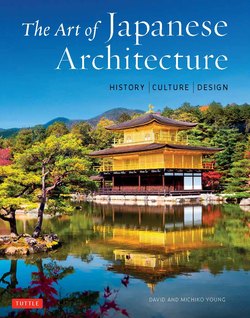Читать книгу The Art of Japanese Architecture - David Young - Страница 17
На сайте Литреса книга снята с продажи.
ОглавлениеNara Period Temples
The West Pagoda of Yakushiji Temple is a recent reproduction of a Nara Period temple. It was reconstructed on the site of an original pagoda dating to around 730.
The Sangatsudō, on the grounds of Tōdaiji, consists of two early buildings covered by a common roof (the Narabidō or “side-by-side” style). Although lacking the symmetry of classic temples, the overall effect is pleasing.
When the capital was moved to Heijōkyō in 710, most Buddhist denominations followed. In addition to the seven great temples of Nara, supported by the State, many private temples were constructed by aristocrats. Compared to the architecture of the preceding period, Nara Period temples, influenced by the Tang Dynasty of China, were on a grander scale.
State Sponsored Temples
Emperor Shōmu, an ardent advocate of Buddhism, established Tōdaiji as the headquarters of a national system of monasteries (kokubunji) and nunneries (kokubunniji). Tōdaiji housed a great bronze Buddha, 17 meters (56 feet) high, that involved nearly 10 percent of the population in its construction and required around 1,665,000 man days to complete. In the year 752, 10,000 priests and dignitaries from many parts of Asia, and as far away as Persia, assembled in Nara to attend the eye-opening ceremony, during which a famous Indian priest painted in the eyes of the Great Buddha (Daibutsu). This ceremony was intended to symbolize the fact that Buddhism had become firmly established in Japan and that the Land of the Rising Sun was now a nation ready to make its own contribution to Asian culture and politics.
EXTANT REMAINS FROM EARLY TEMPLES IN THE NARA AREA
The earliest temples in Japan were mostly destroyed, recycled, or remodeled. As a consequence, it is not always clear which buildings are original. Following is a summary of extant material in the Nara area, in chronological order.
1 Lumber used in the construction of Asukadera, the first temple in Japan (596), is preserved in the Zenshitsu (Meditation Hall) of Gangōji, reconstructed soon after the temple burned in 1451.
2 Hōryūji burned in 670 and was rebuilt some time in the next forty years. It contains the oldest wooden buildings in the world.
3 Three-story pagoda of Hōkiji, sometimes spelled Hokkiji (completed in 706).
4 The east pagoda of Yakushiji (730).
5 The Main Hall, originally the refectory, of Shin-Yakushiji (747).
6 Tegai Gate, Shōsōin, and part of the Sangatsudō (or Hokkedō) at Tōdaiji (around 748).
7 The Main Hall and Lecture Hall of Tōshōdaiji. The date of the former is early but uncertain. The latter, originally part of the Heijōkyō Palace, was moved to Tōshōdaiji in 763 and remodeled in the thirteenth century. Also located on the Tōshōdaiji grounds are two original log storehouses.
8 Miniature pagoda in the treasure house of Goku-rakubō Monastery at Gangōji (late eighth century).
The bell tower with a tile roof at Tōdaiji Temple in Nara. Rebuilt in the Kamakura Period, the tower houses a bell dating to 752. Both the tower and bell are National Treasures.
